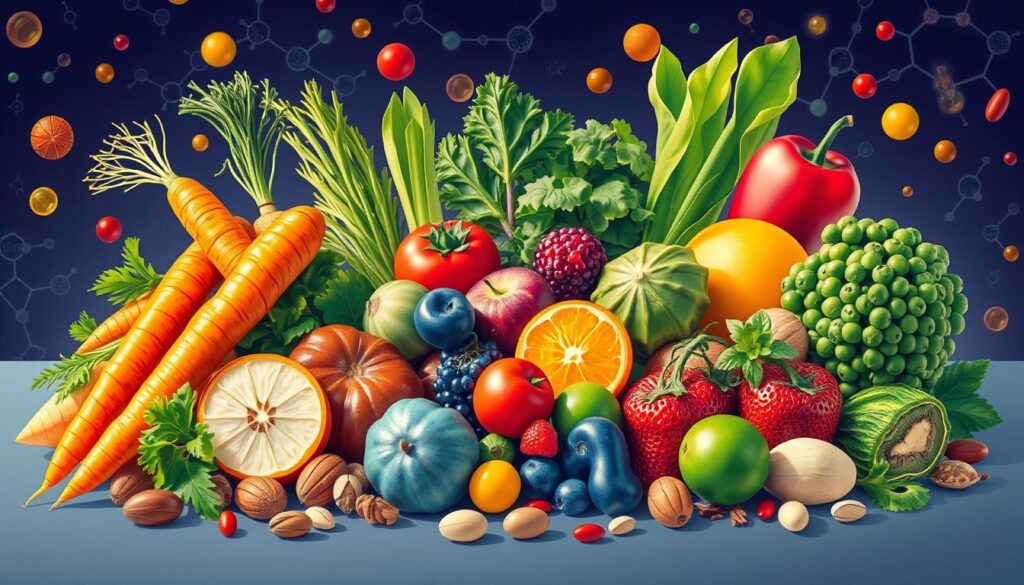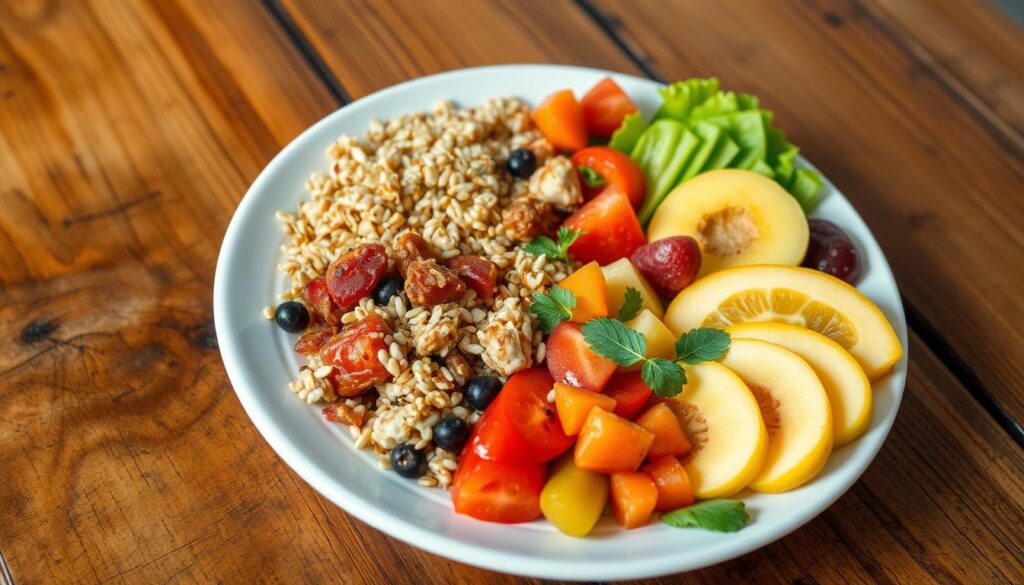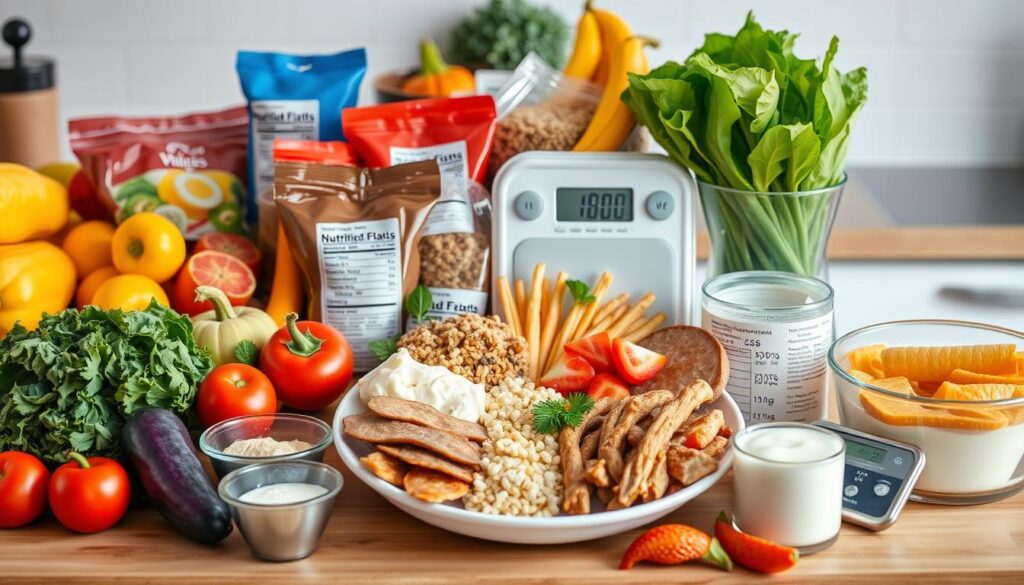Did you know the average American eats over 60 pounds of added sugar each year? That’s more than double what’s recommended! With our growing love for processed foods, knowing what’s in them is key. This guide will help you understand food labels, so you can choose better for your health.
Key Takeaways
- Nutritional information gives us important details about what’s in our food.
- Learning to read food labels helps you make healthier choices and meet your dietary needs.
- Macronutrients (carbs, proteins, fats) and micronutrients (vitamins, minerals) are crucial for our health.
- Knowing daily values and intake guidelines helps you create a balanced diet.
- Being aware of processed foods and adopting healthy habits is essential for good nutrition.
What is Nutritional Information?
Nutritional information tells us about the nutrients in foods and drinks. It shows the calorie count, macro breakdown (like carbs, proteins, and fats), and nutrient data (such as vitamins and minerals). Knowing this helps us make better food choices and stay healthy.
Definition and Importance
Nutritional information breaks down the nutrients in a food or drink. You can find it on labels. It helps us understand the nutritional value and health effects of what we buy. By looking at this info, we can make better choices for our health.
Key Components of Nutritional Information
The main parts of nutritional information are:
- Calories – The energy in food, measured in calories or kilojoules.
- Macronutrients – The main energy providers: carbs, proteins, and fats.
- Micronutrients – Important vitamins and minerals for our body’s functions.
- Other Nutrients – Like dietary fiber, cholesterol, and sodium, which also affect our health.
Knowing these key elements helps us choose better foods. This supports our health and wellness goals.
“Knowledge is power, and understanding nutritional information is the key to unlocking a healthier, more nourished life.”
How to Read Nutrition Labels
Understanding food labels can seem hard, but it’s worth it. Knowing the key parts can help you make better food choices. Let’s look at the important details that guide your decisions.
Understanding Serving Sizes
Serving sizes are key when reading labels. They show how much of the product you usually eat. All nutrition info is based on this amount. So, pay attention to serving sizes to get a clear picture of what you’re eating.
Decoding Nutritional Facts Panel
The Nutrition Facts panel is the heart of any label. It gives you lots of info on what’s in the product. You’ll see calories, macronutrients (like carbs, proteins, and fats), and micronutrients (like vitamins and minerals). Knowing this section helps you choose the right foods for you.
Common Misconceptions about Labels
- Watch out for claims like “low-fat” or “all-natural.” They don’t always mean the product is healthier.
- Don’t think a food is automatically good just because it’s organic or non-GMO. Look at the nutrients too.
- Don’t get fooled by “100 calorie” snacks. Look at the serving size and overall nutrition instead.
By knowing about serving sizes, the Nutrition Facts panel, and common mistakes, you can read labels better. This knowledge lets you make healthier choices that fit your diet and taste.
Macronutrients Explained
Understanding macronutrients is key to a balanced diet. Let’s explore carbohydrates, proteins, and fats. Each is vital for our health and well-being.
Carbohydrates: Types and Functions
Carbohydrates give us energy. They include simple sugars and complex carbs like starches and fiber. Simple carbs give quick energy, while complex carbs release energy slowly, helping control blood sugar.
Mixing different carbs keeps energy steady and aids digestion.
Proteins: Building Blocks for Health
Proteins build and repair our cells and tissues. They come from meat, eggs, dairy, and plants like beans and quinoa. Eating enough high-quality protein is crucial for muscle growth and immune health.
Fats: The Good, The Bad, and The Essential
Fats are vital but often misunderstood. There are good fats like those in avocados and nuts, and bad fats like trans fats in fried foods. Good fats help lower cholesterol and heart disease risk.
By knowing about these nutrients, we can make better food choices. A balanced diet of carbs, proteins, and healthy fats supports energy, muscle recovery, and nutrient intake.
| Macronutrient | Primary Functions | Recommended Intake |
|---|---|---|
| Carbohydrates | Energy, Fiber, Digestive Health | 45-65% of total calories |
| Proteins | Muscle Growth, Repair, Immune Function | 10-35% of total calories |
| Fats | Energy, Hormone Production, Nutrient Absorption | 20-35% of total calories |
The right macro balance varies by individual. A healthcare professional can help find the best mix for you.
Micronutrients Worth Knowing
Macronutrients like carbs, proteins, and fats get a lot of attention. But, micronutrients like vitamins and minerals are the real heroes of our diet. They are tiny but crucial for our health and well-being.
Vitamins: Types and Benefits
Vitamins are essential for our bodies to work right. Vitamin A is great for the skin, B vitamins boost energy, and vitamin C strengthens our immune system. Knowing the vitamin content in our food helps us get the nutrients we need.
Minerals: Essential for Health
Minerals are just as important as vitamins. They include calcium for strong bones and magnesium for our nerves. Getting the right mineral compositions is key to staying healthy and avoiding deficiencies.
The Importance of Fiber
- Fiber is a type of carb our bodies can’t digest but is vital for our health.
- It helps with digestion, keeps us feeling full, and supports good gut bacteria.
- Eating foods rich in fiber, like whole grains, fruits, and veggies, is good for us.
Understanding micronutrients and focusing on them in our diet can greatly improve our health. Exploring vitamins, minerals, and fiber can help us live a more nourished life.

| Vitamin | Function | Good Sources |
|---|---|---|
| Vitamin A | Supports eye health, immune function, and skin health | Carrots, sweet potatoes, leafy greens, dairy products |
| Vitamin C | Boosts immune system, aids in collagen production, and supports wound healing | Citrus fruits, bell peppers, strawberries, broccoli |
| Vitamin D | Promotes calcium absorption, supports bone health, and regulates immune function | Fatty fish, egg yolks, fortified dairy products, sunlight |
The Role of Daily Values
Understanding dietary facts and nutritional information can be hard. But knowing about Daily Values is key. Daily Values tell us how much of each nutrient we should eat daily to stay healthy.
Understanding Percent Daily Value (%DV)
The Percent Daily Value (%DV) is important on nutrition labels. It shows how much of a nutrient a food serving has compared to the daily recommended amount. This helps us choose better foods and get the right nutrients all day.
Recommended Daily Intake Guidelines
- Calories: The daily calorie need changes with age, gender, and activity. Most adults should aim for 2,000 calories a day.
- Macronutrients: The right mix of carbs, proteins, and fats varies. But, a good diet usually has 45-65% carbs, 10-35% proteins, and 20-35% fats.
- Micronutrients: Daily values for vitamins and minerals are set to ensure we get enough. Following these helps meet our body’s needs.
Knowing about %DV and daily intake helps us make a balanced diet. This supports our health and wellbeing.
“Paying attention to the Percent Daily Value can be a game-changer in helping you make nutritious choices throughout the day.”
Special Dietary Needs
Keeping a healthy diet is key, but some people need special nutrients. Athletes, vegans, vegetarians, and those with food allergies or intolerances have unique needs. Knowing what you need can greatly improve your health.
Nutrition for Athletes
Athletes burn more calories and need more nutrients to stay active. They need protein for muscles, carbohydrates for energy, and healthy fats for recovery. It’s important for athletes to know about allergen information and nutrient data to fuel their bodies right.
Vegan and Vegetarian Nutritional Considerations
People on plant-based diets must watch their intake of protein, iron, calcium, and vitamin B12. These nutrients are often found in animal products. They need to plan their meals carefully and might need supplements to meet their nutrient data needs.
Managing Food Allergies and Intolerances
Those with food allergies or intolerances must be careful with allergen information on labels. Eating foods they’re allergic to can cause serious reactions. It’s vital to get medical advice and know your allergen information to stay safe and healthy.
Understanding special dietary needs helps us make better choices for our health. Whether you’re an athlete, follow a plant-based diet, or have food sensitivities, knowing your needs is the first step to a healthy life.
The Impact of Processed Foods
In today’s fast world, processed foods are everywhere. They seem quick and easy, but they can harm our health. It’s key to know how processing changes our food to stay healthy.
How Processing Affects Nutritional Quality
Processing can remove important nutrients from our food. Methods like pasteurization and refining can lessen vitamins and minerals. Ingredient analysis shows that some foods get added bad stuff, like trans fats.
Identifying Hidden Ingredients in Packaged Foods
Reading food labels can be tough. Many foods have hidden ingredients like sugars, sodium, and artificial stuff. Always check the labels to know what you’re eating.
“Processed foods may seem convenient, but the trade-off is often a significant loss of nutritional value. By being vigilant about ingredient analysis and label reading, we can make healthier choices and reclaim control over our diets.
With this knowledge, we can choose better foods. This helps us stay healthy and feel good.
Healthy Eating Practices
Eating well is key to staying healthy. We’ll explore dietary facts and nutritional information to help you eat better. Here are some tips for a healthy diet.
Tips for Building a Balanced Plate
A balanced plate is essential for getting all the nutrients you need. Follow these simple tips:
- Fill half your plate with colorful fruits and veggies. They’re full of vitamins, minerals, and fiber.
- Use a quarter for lean proteins like grilled chicken, fish, or tofu.
- Save a quarter for whole grains like brown rice or quinoa. They offer complex carbs and fiber.
- Add a serving of healthy fats like avocado or nuts to support your health.
Importance of Whole Foods
Whole, unprocessed foods are the best for your diet. They’re full of nutrients, fiber, and plant compounds that boost health. Choosing whole foods over processed ones is crucial for your dietary facts and nutritional information.
Meal Planning for Nutritional Balance
Good meal planning is vital for a balanced diet. It helps you meet your nutritional needs. Here are some tips:
- Plan a weekly menu with a variety of healthy foods.
- Make a grocery list to avoid buying unhealthy items.
- Batch cook meals to have quick, healthy options.
- Try new recipes with different whole foods and flavors.
By following these tips, you’ll improve your dietary facts and nutritional information. This will help you stay healthy and full of energy.

Tools for Tracking Nutritional Information
We’re excited to share tools that make tracking nutrients and calories easy. These apps, websites, and scanners will help you on your health journey. They’re your guides to better health and wellness.
Apps and Websites to Use
Tracking your nutrition is now simple with apps and websites. Apps like MyFitnessPal and websites like Cronometer give you all the info you need. They put nutrient data and calorie counts in your hands.
- Food Scan Genius: the World’s #1 AI assistant for shoppers with Food Allergies &/ Dietary Preferences
- MyFitnessPal: A popular app for logging meals and tracking nutrients and calories.
- Cronometer: A detailed tracker that offers nutrient data, calorie counts, and health insights.
- USDA Food Composition Database: A vast online resource for food nutrient and calorie information.
We recommend that you download Food Scan Genius today and try it for yourself – its free!
Label Scanners and Food Diaries
For a hands-on approach, try label scanners and food diaries. They help you quickly find nutritional info, whether shopping or cooking.
- Label Scanners: Apps like Fooducate and Ingredient Scan show nutrition info with a camera scan.
- Food Diaries: Writing or digital journals track your nutrient and calorie intake over time. They help you make better choices.
Using these tools empowers you to make informed choices about your nutrition. They support your journey to optimal health and wellness.
Conclusion: Empowering Your Health Through Nutrition
As we wrap up our exploration of nutritional information and dietary facts, it’s clear that knowing these is key. You now understand the basics of nutrition, how to read labels, and the role of macronutrients and micronutrients.
The Importance of Informed Choices
With what you’ve learned, you can make better food choices. This knowledge helps you choose whole foods, spot hidden ingredients, and meet your dietary needs. It’s great for anyone looking to live a healthy life.
Making Nutrition a Priority in Daily Life
Now, it’s time to use what you know every day. Start with simple meal planning, track your nutrients, and make smart grocery choices. These steps can change how you see food and improve your health. Remember, small changes can make a big difference over time.
FAQ
What is nutritional information?
Nutritional information is the data on food labels that shows what’s in a food. It tells you about calories, carbs, proteins, fats, vitamins, and minerals. This helps you know what you’re eating.
Why is nutritional information important?
Knowing what’s in your food helps you make better choices. It lets you see how a product stacks up against others. This way, you can meet your dietary needs and goals.
What are the key components of nutritional information?
Key parts include serving size, calories, and fats. You’ll also see sodium, carbs, fiber, sugars, and proteins. Sometimes, it lists vitamins and minerals too.
How do I read and understand nutrition labels?
Start with the serving size and how many servings are in the package. Look at the Nutrition Facts panel. It shows calories, nutrients, and more for each serving.
What are the different types of macronutrients and their functions?
Macronutrients are carbs, proteins, and fats. Carbs give you energy. Proteins build muscles and tissues. Fats help with energy and other body functions.
What are the important micronutrients to be aware of?
Important micronutrients are vitamins A, C, D, and B-complex, and minerals like calcium and iron. They help your body work right and keep you healthy.
What is the percent daily value (%DV) and how do I use it?
The %DV shows how much of a nutrient you get from one serving. It helps you see if a food fits into your daily needs.
How do I adjust my nutritional intake for special dietary needs?
For special diets, like vegan or athletic needs, focus on certain nutrients. A healthcare pro can help you meet your specific needs.
How do processed foods affect nutritional quality?
Processed foods may lose nutrients due to refining and adding artificial stuff. Always check labels and choose whole foods when you can.
What are some healthy eating practices based on nutritional information?
Eat a variety of whole foods for balanced meals. Choose foods high in fiber and stay hydrated. Use nutritional knowledge to keep healthy.
What tools are available for tracking nutritional information?
Apps, websites, and tools help track what you eat. They can count calories and scan labels. These tools help you understand your diet better.






18 Comments
Your comment is awaiting moderation.
[…] Understanding food allergies can be tough, with many myths around. Our food allergy scanner helps clear up confusion. It gives accurate info on possible allergens. […]
[…] steer clear of Albumin, Lysozyme, Binder, Ovalbumin, and others found on labels3. Those with milk protein allergies should avoid butter, cream, casein, and whey on labels3. Wheat protein allergies mean […]
[…] protein: Greek yogurt and eggs are excellent sources of high-quality protein. […]
[…] Scores products based on nutritional quality […]
[…] be good for you. But, it’s important to make sure you get all the nutrients you need. Some vitamins and minerals might be missing, especially if you’re new to this […]
[…] these allergens isn’t just about avoiding them—it’s about staying safe and informed. Whether you’re a parent managing a child’s […]
[…] fava beans, and edamame bring the protein […]
[…] Processed foods, protein supplements […]
[…] the years, digital tools have evolved to provide deep insights into ingredients and nutritional quality. For example, the Yuka app has over 55 million users worldwide, showing how popular these tools […]
[…] example, a food label might say, “May contain traces of nuts.” This means the food product could have come into […]
[…] free from most allergens and a great way to add variety to your meals. If you’re looking for protein, check out plain meats or fish in the deli section—just double-check for any added […]
[…] goals (low sodium, high protein, […]
[…] cells travel to lymph nodes. There, they teach T-cells to react. If they teach T-cells that peanut protein is dangerous, you become allergic. Over time, this reaction can last a […]
[…] are often the culprits behind allergic reactions. For example, the protein in wheat can trigger symptoms in sensitive individuals. Manufacturers are required to list these […]
[…] the grocery store aisles can feel like a minefield for those with specific dietary needs. For millions of people, a simple meal choice can have serious consequences. That’s where food […]
[…] The app scans barcodes and provides detailed information about food ingredients, including common food allergies. […]
[…] nutritional information at your […]
[…] Monitor calorie and nutrient intake […]
[…] This feature is particularly valuable when navigating the often-confusing world of packaged and processed foods, where hidden carbs and sugars can easily derail your dietary […]